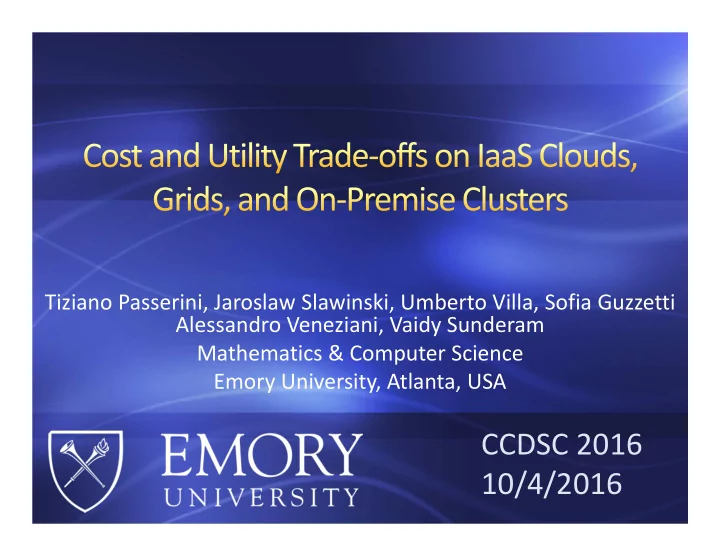

Tiziano Passerini, Jaroslaw Slawinski, Umberto Villa, Sofia Guzzetti Alessandro Veneziani, Vaidy Sunderam Mathematics & Computer Science Emory University, Atlanta, USA CCDSC 2016 10/4/2016
• Equivalent platforms for unmodified application c o r e Application Intra/Inter ‐ net RAM IB, low latency SMP VO, P2P, etc. Cluster, supercomp • Single OS • Heter. CPUs • Homogen. CPUs • Parallel • Distributed • Soft precon’d (threads, Logical view computing • Good network OpenXYZ, MPI) • I have my application Virtualization, IaaS clouds • I need some CPU(s) • Look: soft condition to have • Do I care about a resource like above comm/io? Maybe • Feel: depends (on coupling) 10 Gb/s eth
• If different computational platforms may be used interchangeably … Not real data Turnaround time [in time or effort units] 80 70 60 50 40 30 20 10 0 Dev cluster Single node Supercomputer IaaS cloud Soft preconditioning Waiting for resources Computation
• Dev environment – no soft conditioning • “Rented” resources – no up ‐ front costs Not real data Distribution of costs per execution [in virtual dollars] 200 180 160 140 120 100 80 60 40 20 0 Dev cluster Single node Supercomputer, VO IaaS cloud Amortized up ‐ front Amortized admin Comp. & storage or energy
Case study: LifeV ‐ based hemodynamic simulation • CFD/FEM MPI parallel code • LifeV library • Issues – Process placement – Turnaround – Cost • Utility
• FEM input mesh partitioned into 8 partitions (8 processes) • Logical topology graph • Physical topology • How to match? 400 Affinity zones 350 CPU cores 300 250 200 Scotch 150 Internode connection 100Gb/s 100 50Gb/s 50 1Gb/s 0 0 1 2 3 4 5 6 7
• M – data from the partitioner • D – data from benchmarks • I – inverted D • Round ‐ robin and per ‐ core – input ‐ agnostic allocation
NP
1 4 3 2 5 • Diagnosis • Bypass or stent placement • Cost vs. turnaround
1. Ellipse: university cluster 256 ‐ node 1k ‐ core; 1Gb/s ethernet; queue SGE 2. Puma: dev environment cluster 32 ‐ nodes 128 ‐ core; IB SDR; queue PBS 3. Lonestar: XSEDE supercomputer IB QDR; queue PBS 4. Rockhopper cluster: On ‐ Demand HPC Cloud Service, Penguin Computing IB QDR; queue PBS 5. Amazon EC2; 1 ‐ 16 nodes cc2.8xlarge 16 ‐ core per node; 10Gb/s ethernet
• Aneurism simulation • About 1 million elements (FEM) • Computes pressure and velocity for each 0.01 sec • Same problem, various number of processes (strong scalability test) • One MPI process per computing core in round ‐ robin placement
• A – fastest overall • B – supercom ‐ puter nodes are not the fastest • C – single EC2 = 16 processes on supercomputer • D – fastest EC2 configuration • EC2 scalability…
Avg is 4h 44m
• Puma and Lonestar – estimated cost based on hardware/ operational expenses; typical figures reported in literature • Ellipse – university pricing • Rockhopper – actual charges • EC2 – we used as many cheap spot ‐ request (bid ‐ based) instances as possible (about 6 times cheaper than regular instances)
• Value of simulation results to user over time • T * ‐ expected completion • U – utility value (e.g., in $) time • U max – the max value the • |T * ‐ T 0 | ‐ delay tolerance user is willing to pay (importance of the task) • T 0 – latest completion time
Range of min. prices per simulation for all architectures: $3.53 ‐ $22.59 Avg. $10.30
Low (3), high (1), average (2) priority jobs T* = 4.44 hrs #3 = $10.31 #1 = $20.62 A – overall fastest execution C – overall cheapest execution D – fastest time for EC2
• Turnaround vs. cost tradeoffs vary considerably across platforms (multiplied by parameter sweeps) • Some IaaS cloud resources offer superior capabilities compared to cluster/supercomputer nodes (large single instances vs. local clusters) • Queue waiting time is not considered in this study, but it may significantly change selection decisions for time ‐ critical computation (e.g., medical diagnosis)
Recommend
More recommend